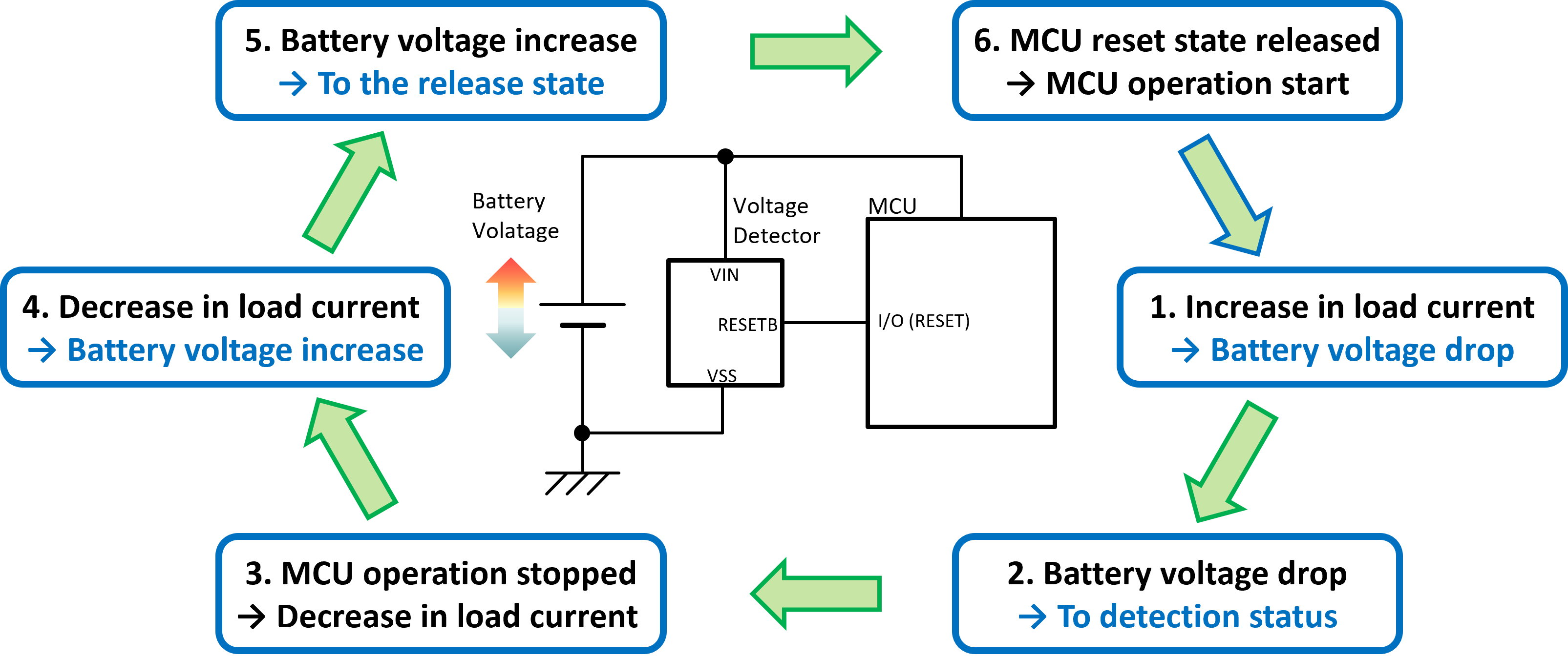Here explains what kind of phenomenon occurs referencing the case when the hysteresis width of detect voltage / release voltage of voltage detector is small.
If the hysteresis width is small
Assume a circuit that monitors battery voltage with a voltage detector for which MCU is connected to a battery with large internal impedance such as coin battery.
In such a case, phenomenon in which detection and release of voltage detector are repeated may occur.Here explains how such a situation actually occurs in chronological order from steps 1 to 6.

1. If the battery current increases, the battery voltage decreases due to the battery current and the battery's internal impedance.
2. If the battery voltage decreases, the voltage detector enters the detection status.If the voltage detector enters the detection status, a reset signal will be sent to MCU to stop the operation of MCU.
3. If MCU stops the operation, the load current decreases.
4. If the load current decreases, the voltage drop due to battery current and battery's internal impedance gets eliminated and the battery voltage increases.
5. If the battery voltage increases, the voltage detector enters release status and operates MCU.
6. The load current (battery current) of MCU increases.
* Steps 1 to 6 are repeated, detection and release statuses of voltage detector will be repeated.
To prevent detection and release of voltage detector
The phenomenon in which detection and release of voltage detector are repeated is caused by fluctuation of battery voltage due to load current. If the fluctuation range of battery voltage is larger than the hysteresis width of voltage detector, detection and release statuses of voltage detector are repeated.
This time, the voltage fluctuation due to battery's internal impedance was taken as an example. However, even in the resistance components of fuses and filter circuits, the voltage fluctuation of a line monitored by voltage detector occurs and it causes repetition of detection and release statuses of voltage detector.
The followings are available as general measures.
・ Setting the hysteresis width larger than voltage fluctuation range of battery voltage (monitoring line)
・ Changing the battery with a battery whose internal impedance is small / changing the fuse filter with a fuse filter whose DCR is small
For other than voltage detector
A case example was explained as shown above referencing the voltage detector. However, a similar phenomenon occurs in devices other than voltage detector.
The followings are case examples in which hysteresis width was small and detection and release statuses were continued.
(a) When the hysteresis width of UVLO detect voltage and release voltage of voltage regulator or DC/DC converter equipped with UVLO function is small
(b) When the hysteresis of CE/EN "L" voltage and "H" voltage of voltage regulator or DC/DC converter equipped with CE/EN function is small
In addition to case examples shown above, a case example in which abnormal status and startup / steady status are repeated occurs if overcurrent protection, overheat protection, or low voltage protection, etc. of IC or circuit operates.
It is important to comprehend the operation of ICs and parts in the entire circuit instead of just seeing a single IC or part to design a circuit.